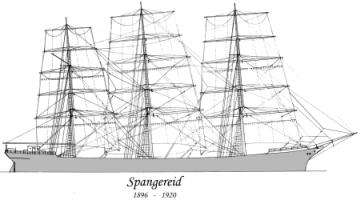 We recently posted about the 105th anniversary of the Battle of the Falklands and the discovery of the wreckage of the German armored cruiser, SMS Scharnhorst, which was sunk in the battle. In researching these posts there was one bit of historical trivia which seems worth sharing — the appearance of a sailing ship, which sailed directly between the combatants at the beginning of the battle.
We recently posted about the 105th anniversary of the Battle of the Falklands and the discovery of the wreckage of the German armored cruiser, SMS Scharnhorst, which was sunk in the battle. In researching these posts there was one bit of historical trivia which seems worth sharing — the appearance of a sailing ship, which sailed directly between the combatants at the beginning of the battle.
The battle was a disaster for the German squadron under the command of Vice-Admiral Maximilian Graf von Spee. His German East Asia Squadron of 2 armoured cruisers, 3 light cruisers, and 3 transports was outnumbered and outgunned by the British squadron of 2 battlecruisers, 3 armoured cruisers, 2 light cruisers, and 1 pre-dreadnought commanded by Vice-Admiral Sir Frederick Doveton Sturdee. All the German ships would ultimately be lost, save one transport which escaped. The British suffered 10 killed with 19 wounded, while the Germans lost 1,871 including Admiral Spee and his two sons.
Just as the British and Germans began to engage, according to (British) CDR H. Spencer-Cooper, “at this juncture a full-rigged sailing ship appeared on the port hand of our battle cruisers; she was painted white, and her sails were shining as if bleached in the bright sunlight… So close was she that the Admiral was forced to alter his course to pass a couple of miles clear of her so that the enemy’s shell ricochetting should not hit her.”
The ship was the Norwegian flag three-masted Jubilee-rigged steel sailing ship Fairport, homeward bound from Chile. Lacking a radio, the ship’s captain reportedly did not know that the war had broken out until he saw and heard the battle cruiser’s guns blazing from behind the clouds of coal smoke belching from their boilers.
Perhaps fortuitously, this was the Fairport’s first voyage under the Norwegian flag. She was built in 1896 by the Scottish shipbuilder Russell & Co. Ltd. at Greenock for Liverpool owners. Renamed Spangereid, she sailed until 1920 when she burned at St. Helena after her cargo of coal caught fire.

I cant help but ownder if the sailing ship altered the course of the battle. As well as what fool would knowingly want to sail into battle? My first impression would be to steer clear of any naval engagement. The crew and the cargo are worth more than that of curiosity.
Sailing ships do not always have the option of altering course as the saying says “the wind commands” Battles such as the Falklands were fought over great distances often duels between individual ships. I have photographs of the graves of those lost from HMS Kent these in the Falklands Islands Cemetery at Stanley, I would offer to post them, I have made offers in the past on various maritime matters unfortunately neither Rick or anyone else has answered previously, I say again how.